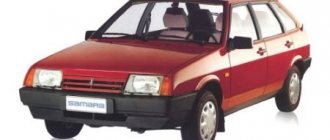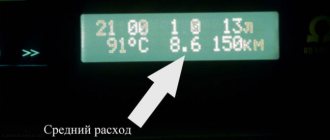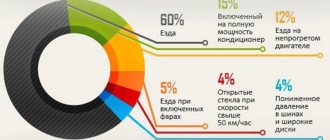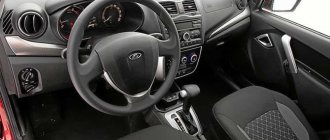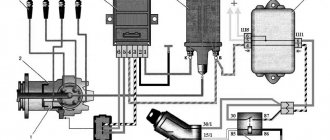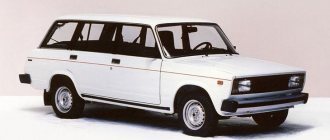The main indicator of economical operation of a car engine is specific fuel consumption. There are several methods for determining it. Every manufacturer wants their cars to have this figure as low as possible. Therefore, the methods for determining gasoline consumption differ from one another. The Russian manufacturer represented by AvtoVAZ claims that the fuel consumption of the Lada Granta averages 6.7-7.7 l/100 km in the combined driving cycle. However, passport data does not always coincide with actual results.
How are fuel consumption standards determined?
Gasoline consumption is determined in laboratory conditions. There are special techniques for this. For example, in Europe, consumption is determined according to NEDC standards - the new European driving cycle. The standard was last updated in 1997. Its disadvantage is that the choice of vehicle and test conditions is at the discretion of the automaker. Instead of a new car, a run-in version of the tested model can be used and almost perfect conditions created for this (windows closed, air conditioning, headlights and MMC turned off, etc.).
To simulate driving in the city and on the highway, different testing times are selected. Special rubber and low viscosity lubricating oil may be used. The presence of these factors leads to the fact that gasoline consumption standards appear in the car's passport, which are far from the true ones. The American and Japanese methods are more stringent, so the documents indicate values that are close to objective. In some cases, if you buy a car with a passport consumption of 7.5 liters per 100 km, in reality it turns out that it consumes 10-12 liters. This figure may increase depending on the season, fuel quality, load, road and engine conditions and many other factors. Therefore, drivers themselves try to determine specific fuel consumption and take measures to reduce it.
How to find out the consumption yourself
The method described here allows you to determine as accurately as possible for your specific case the amount of fuel burned per 100 kilometers.
The procedure is as follows:
- Having used up the fuel as completely as possible, fill the tank to capacity, that is, until the dispenser pistol fires the first “shot”;
- the daily mileage scale is set to zero;
- after one day, compare the distance covered by the car with fuel consumption.
For example, if you drove a conventional 400 kilometers and consumed 31 liters of fuel, then dividing the amount of liters by the first number and multiplying the result by 100, we get 7.75, which is the real value for you.
By acting in this way, you will know exactly what the exploitation of Grants will cost you.
In principle, the Granta’s power plant belongs to the small-displacement category. Such vehicles in general are not capable of consuming a lot of fuel. However, there are many factors that directly influence this indicator. We will talk about them in more detail below.
What factors influence the fuel consumption of the Lada Granta?
Fuel consumption when driving under standard conditions depends on the following factors and is:
- driving - 60%;
- operation at full air conditioner power - 15%;
- driving on a cold engine - 12%;
- traveling with lights on - 5%;
- open windows at speeds over 50 km/h - 4%;
- low tire pressure - 4%.
Gasoline consumption on the Lada Granta may increase due to:
- low quality fuel;
- using tires that are not appropriate for the season;
- unsatisfactory condition of the engine and systems serving it;
- aggressive driving style;
- condition of the road surface;
- use of powerful additional electrical equipment;
- installing a trunk, air box or driving with a trailer.
In winter, when the engine warms up, fuel consumption increases by 1.5-2 liters. Driving around the city during rush hour significantly increases fuel consumption. In some cases, consumption can reach 15-19 l/100 km.
Using gasoline with a low octane number not only increases its consumption, but also leads to engine overheating.
Lada Granta fuel consumption table by kilometer
The table contains the distances most often of interest and the corresponding fuel consumption indicators by kilometer for the Lada Granta. The data in the table is averaged and does not take into account the modification and equipment of a particular car, but uses the average data for the model.
| Distance (km.) | Fuel consumption, l | ||
| MIN (track) | MAX (city) | ||
| 200 (two hundred) | 10,40 | 20,20 | |
| 300 (three hundred) | 15,60 | 30,30 | |
| 400 (four hundred) | 20,80 | 40,40 | |
| 500 (five hundred) | 26,00 | 50,50 | |
| 600 (six hundred) | 31,20 | 60,60 | |
| 700 (seven hundred) | 36,40 | 70,70 | |
| 800 (eight hundred) | 41,60 | 80,80 | |
| 900 (nine hundred) | 46,80 | 90,90 | |
Fuel consumption of 8-valve engines
The first copies of the Lada Granta, which appeared in 2011, were equipped with gasoline injection engines models 11183 and 11186 with a volume of 1.6 liters and a power of 82 and 87 hp. respectively. The use of a power supply system with distributed injection and a lightweight connecting rod and piston group made it possible to achieve a reduction in consumption in all driving modes. With a combined cycle, the 82-horsepower Lada Granta has a gasoline consumption of 7.4 liters, and with the 11186 engine - 7.0 liters per 100 km. When driving in the city it will be 9.7 and 9.0 l/100 km, and on the highway - 6.1 and 5.8 l/100 km, respectively.
In fact, the fuel consumption of the sedan differs significantly from the official data: outside the city it is about 6.6 liters, and in the combined cycle - 8.5 l/100 km. Differences in fuel consumption largely depend on the operation of the vehicle under conditions that differ significantly from laboratory conditions (ground tests). The use of low quality fuel and lubricants makes a significant contribution.
Gasoline costs
Official data states that the fuel consumption rate of the Lada Granta on the highway is 5.6 liters, in the combined cycle no more than 6.8 liters, and in the city only 8.6 liters per 100 kilometers.
These figures apply to all engine types.
Real fuel costs range from 5 to 6.5 liters outside the city, depending on engine power. And the average gasoline consumption of the Lada Grant in the city reaches 8-10 liters per 100 km. Winter mileage increases by 3-4 liters in all types of engines.
Fuel consumption of 16-valve engines
Installing 4 valves per cylinder made it possible to reduce the load on the engine, which had a positive effect on reducing fuel consumption and at the same time increasing the power of the power unit. The cars were equipped with engines 21126 (98 hp) and 21127 (106 hp) with a volume of 1.6 liters. Frets with such engines had both a mechanical and a robotic gearbox. According to the passport data, fuel consumption standards per 100 km for cars with a 98 hp power unit. are:
- urban cycle - 9.9 l;
- highway - 6.1 l;
- mixed cycle - 7.6 l.
Despite the fact that the 21127 engine has more power, it consumes slightly less fuel:
- city roads - 8.6 l;
- highway - 5.6 l;
- mixed cycle - 6.7 l.
Actual costs differ from the passport costs and amount to 10-12 liters for the city and 7 -7.5 liters when driving on suburban highways.
Lada Granta with an 87 hp engine.
A more powerful modification of the Lada Granta is equipped with an engine with the same displacement of 1.6 with 87 horsepower with a torque of 140 Nm and improved dynamics of 12.2 s to the first hundred. The maximum speed in this configuration is 167 km/h with gasoline consumption:
- in traffic 9 l;
- on average 7 l;
- on the highway 5.7 liters.
Owner reviews on fuel consumption
- Alexander, Kerch. I took the Lada Granta 2021 from the showroom because I always liked the appearance of the car. I chose the option with an eight-valve 1.6 engine with 87 horses, because I consider it the most reliable. I put the car in for service and only changed the oil and filters. As for fuel consumption, on the highway it’s 6 liters, in the city it’s no more than 10 liters, even in winter.
- Stepan, Samara. For my family of four, Lada Granta is the best option. It feels good in the city; you can take your family out to the countryside or on a picnic. You can fit everything you need in the trunk. The suspension and transmission are reliable, the 87 horsepower engine pulls great, there were no problems with it. Average fuel consumption is 7.5 liters in summer and about 8 in winter.
- Yaroslav, St. Petersburg. I bought a Lada Granta at a dealership, hoping for the high build quality that the manufacturer declared. Maybe I got such a car, but I am dissatisfied with it, especially in terms of reliability and comfort. The interior is noisy, there are constant problems with the suspension and fuel supply system. Consumption is admittedly small, 6-9 liters per hundred, but I’m still thinking of selling it.
- Ivan, Orenburg. I have a Lada Granta 1.6 2104 with a manual transmission. So far I like everything, the car is reliable, unpretentious, spare parts are inexpensive. The suspension is adapted to our roads, the engine is 87 hp. starts easily in the most severe frosts. Fuel consumption on the highway is 6 liters, in traffic jams it rises to 9.
- Vyacheslav, Khanty-Mansiysk. I picked up a Lada Granta in 2015, bought it in the showroom, with an 87-horsepower engine. I was pleasantly surprised by the build quality and comfort in the cabin, which is completely uncharacteristic of the domestic auto industry. The suspension is somewhat harsh, but handles road irregularities well. Fuel consumption does not exceed 9 liters even in winter; on the highway you can keep within 6 liters.
- Nikolay, Rostov. I took my Lada Granta in 2021 from my hands, a 1.6 engine with 87 horsepower with a five-speed manual transmission. So far I have driven less than 20 thousand km, I have no complaints about the car. It is easy to control, dynamic, and cheap to repair. Spacious and comfortable interior, trunk - everything for people. The consumption is also good - 7 liters all around, I only use AI 95 or AI 98.
Features of consumption depending on the gearbox
Cars with an automatic transmission (automatic transmission) consume more fuel than those with a manual transmission (manual transmission).
This is due to the fact that the robot switches gears with a delay, i.e., to switch to a higher gear, higher engine speeds are required than with a manual transmission.
This is especially noticeable when driving within the city. Gasoline consumption for cars with automatic transmission in this case is 11-12 l/100 km. On the highway, these figures are slightly lower and fluctuate between 7.5-8.5 l/100 km. In winter, gasoline costs increase by 2-2.5 l/100 km. On cars with a manual transmission, fuel consumption under the same conditions is 2-3 liters less.
Due to the high cost and high fuel costs, cars with a robotic gearbox are in less demand among potential Lada Granta owners.
Options for reducing fuel consumption
The fuel consumption of the engine directly depends on the above factors that affect the increase in gasoline costs. To reduce fuel consumption, you need to:
- check all engine systems for serviceability;
- monitor the electronic system;
- detect injector problems in time;
- regulate fuel system pressure;
- clean air filters in a timely manner;
- turn off headlights if they are not needed;
- drive the car smoothly, without jerking.
The transmission plays an important role in fuel consumption. Owners of a VAZ with a manual transmission have lower costs than drivers of a Lada Granta automatic. Therefore, when choosing a car of this model, you need to take into account all the factors that influence moderate fuel consumption.
Lada Granta cars are one of the few that have a powerful engine and relatively low fuel consumption. This is one of the main advantages in a series of budget cars.
How to measure fuel consumption yourself
On car enthusiast forums you can often find messages that their Ladas consume from 14 to 18 l/100 km when driving around the city or 8-9 l when driving outside the city. Despite the presence of an on-board computer, many car owners try to calculate specific fuel consumption themselves. It happens that the result is less than the computer readings, and sometimes vice versa. In this case, you must contact a service station to diagnose the engine.
Test lamp method
To ensure accurate fuel consumption measurements, you must drive at least 1 thousand km. When the minimum fuel reserve warning light comes on, less than 7 liters of gasoline remains in the tank. The car is filled with fuel until the gas tank is full. After this, the odometer is reset, and the car is operated in everyday mode until the light comes on. The car is filled with AI 95 gasoline and so on until the mileage is 1 thousand km. After the next signal lights up, readings are taken and the average fuel consumption is determined.
The calculation is carried out using the formula: (V/L)x100, where V is the total amount of gasoline filled, and L is the control mileage of the car. If the result differs from the passport data and exceeds 10 liters, check the serviceability of the systems. To do this, the on-board computer readings are reset and a test drive is carried out on an open road at a constant speed of 80-90 km/h.
The mileage per trip should be 5-10 km. If, as a result of measurements, the consumption according to the on-board computer is in the range of 4.5-5.5 liters, it means that the engine is working normally, and the increased fuel consumption is associated with driving style or the congestion and condition of the roads. Otherwise, you need to contact a car service.
From tank to tank
With this method of determining the average fuel consumption, the result is less accurate than in the previous one, but it will qualitatively show the excess or value of the specified fuel consumption. To do this, the odometer and computer readings are reset, and the fuel tank is filled up to the neck so that the gasoline level is visible. The vehicle must travel at least 300 km in various modes. The longer the mileage, the more accurate the result will be.
After all the gasoline has been used up, the car is refueled to the same level as before taking measurements. The average consumption is determined by the same formula as in the previous case. The calculated data is compared with computer readings. If the difference is large, then it is necessary to check the readings and, if necessary, calibrate the fuel consumption on the device.
Measurement results may vary due to the quality of gasoline. Therefore, it is recommended to carry out measurements while replenishing fuel at one gas station. In case of increased consumption, you need to measure it while refueling at a gas station of another network.
Main technical factors that affect fuel consumption
The fuel consumption of a car is mainly affected by:
- The quality of the fuel itself. If you are unlucky and the car was filled with bad fuel instead of good fuel, then you will have to drain all the gasoline from the tank.
- cleanliness of filters (air and fuel filter). You can diagnose these breakdowns yourself. The most common reasons are failure to comply with filter replacement deadlines.
- Correct operation of sensors and engine control system.
- Incorrect operation of the engine itself as a result of wear or incorrect running-in.
- Flat tires. Incorrectly selected tire pressure greatly affects fuel consumption.
- Incorrect type of engine oil. To prevent this from happening, you need to pay careful attention to the choice of oil. Read more in the materials: about choosing oil for an 8-valve engine, about choosing oil for a 16-valve engine.
- Wear of brake mechanisms. In this case, the pad may come into contact with the brake disc as a result of a breakdown of the brake mechanism. This situation is very common. This is due to poor drainage systems; water gets into the brake mechanisms and disrupts their operation, knocking out the lubricant, resulting in the mechanisms “souring.”
- Movement on an unheated engine. This is of course a controversial issue. Due to the design of the cooling system, the engine temperature rarely rises above 80 degrees in cold weather. Previously, this phenomenon was considered a breakdown, but now, on the contrary, AvtoVAZ has issued the opposite order and removed the engine temperature indicator completely on the first models.
Equipment
This is one of the most significant factors on which the overall fuel consumption of a car depends. In particular, we mean differences in:
- types of bodies;
- types of power units;
- electronic equipment;
- manual or automatic transmissions, etc.
For example, the sedan and liftback are each produced in three modifications. The difference lies in the power of the unit and, accordingly, their gluttony also varies. So:
- a 98-liter engine will burn 7.8 liters at normal rates;
- at 87 – 7.2;
- at 106 – 6.9.
It is worth knowing that the weakest of them has 8 valves, while the others have 16.
The designers made the only exception for Grants sport. This model is equipped with a 1.6-liter power unit (this parameter is the same for all cars), but its power is higher - 118 l/s. Moreover, the sports version is also equipped with a 5-position gearbox.
What is curious is that with all this, having a 16-valve engine, the above-mentioned model, according to the manufacturer’s standards, spends only 6.8 liters per hundred kilometers. This is a very modest figure in comparison with other relatives.
Sedan and liftback body
The Lada Granta sedan went on sale in 2011 and immediately became a popular car model. The reason for this was the massive purchases of this particular car: two years after its release, every 15 purchased car was a Lada Granta sedan. Of the three known trim levels - Standard, Normal and Luxury, the most affordable option is the standard. The engine capacity is 1.6 liters and the power is 82 hp. With. makes this 4-door model not only a budget, but also a practical economy class car. And the average gasoline consumption of the Lada Granta sedan is 7.5 liters per 100 kilometers.
Before the release of the new Lada model, many became interested in how much it would change. As a result, the technical characteristics of the liftback are not very different from the sedan. This car entered the market in 2014. The main changes are visible in the exterior of the car and in the 5-door configuration. Other functional devices remained the same or were improved. The lack of changes can be seen on the car configuration, which was transferred from the Grant sedan. Fuel consumption in such cars is slightly higher, as engine power has increased.
Gasoline consumption Lada Granta 8 and 16 valves, city, highway, combined cycle
Factory settings
There are certain methods for determining the average fuel consumption of a car engine. By the way, they are approved by law. The car is not tested at testing grounds, but is driven to special laboratories with “ideal” conditions. Next, the wheels of the car are installed on the drum, which simulate urban and suburban operating conditions. That is why, in most cases, the actual consumption does not coincide with the factory one.
Let's add to this the factor that the driving style is different for most drivers.
Fuel consumption of 8 valve engines
The data is presented for Lada Granta cars equipped with a manual transmission.
| Engine (model) | Engine power (hp) | Engine capacity (cc) | Fuel consumption in the urban cycle (l/100 km) | Fuel consumption outside the city (l/100 km) | Combined fuel consumption (l/100 km) |
| 11183 | 82 | 1596 | 9.7 | 6.1 | 7,4 |
| 11186 | 87 | 1596 | 9 | 5.8 | 7,0 |
| 21116 | 87 | 1596 | 9 | 5.8 | 7,0 |
Fuel consumption of 16 valve engines
The data is presented for Lada Granta cars equipped with a manual transmission.
| Engine (model) | Engine power (hp) | Engine capacity (cc) | Fuel consumption in the urban cycle (l/100 km) | Fuel consumption outside the city (l/100 km) | Combined fuel consumption (l/100 km) |
| 21126 | 98 | 1596 | 9.9 | 6.1 | 7,6 |
| 21127 | 106 | 1596 | 8.6 | 5.6 | 6,7 |
As can be seen from the tables, the consumption of 16-valve engines is slightly lower than 8-valve engines. And the version with a powerful engine costs more.
All tests are carried out on 95-octane gasoline; all Lada Grant engines are designed for this octane number.
How to measure fuel consumption yourself?
There are two main ways to measure average fuel consumption. If the fuel consumption of your car differs significantly from the factory parameters, then it is necessary to diagnose the cause.
Test lamp method
The simplest of them, and, as it seems to me, the most biased, is carried out using a fuel warning lamp. Its essence is as follows:
- As soon as your gas station indicator light comes on, you need to fill up with 20 liters of fuel.
- Reset daily mileage.
- Wait until the gas station indicator light comes on again and divide the distance traveled by 2. For example, if you have driven 300 km, then you need to divide 300 by 2 (300/2 = 150 km). This means you can travel 150 km on 10 liters. Or divide 20 by 300 and multiply by 100, it turns out that in this case your fuel consumption was 6.6 liters per hundred kilometers.
This method cannot be called accurate, especially considering that the warning lamp on the Lada Granta lights up whenever it wants, from any hill, and can even light up from a sharp press on the brake pedal (emergency braking).
From tank to tank
This method is the most accurate if you follow all the rules. Its essence is as follows:
- If there is a minimum amount of fuel left in the tank, it is necessary to fill the tank full before the first “shooting” of the gas station pistol.
- Reset daily mileage.
- Wait until the fuel level drops to the minimum level (the lower the level, the more accurate the measurement will be) and refuel to a full tank again, before the first “shoot” of the gas station pistol.
- Next, compare the daily mileage readings and the amount of fuel that fits in the gas tank. For example, if you drove 500 km and spent 41 liters of fuel, then the fuel consumption of the car will be (41/500) * 100 = 8.2 (8.2 liters per 100 km.)
It is by this method that I recommend checking the readings of the on-board computer and the actual fuel consumption of your car!
The world's main methods for measuring the consumption of new cars
As we wrote above, there are several methods for measuring the average fuel consumption of cars. Let's tell you more about them.
In Europe, the most commonly used cycle is the NEDC type, which was developed about forty years ago. This causes reproaches from experts who talk about the outdatedness of the method.
The main features can be considered that manufacturers are allowed to use a selective method for selecting a machine. We are talking about the fact that for testing we provide cars with already run-in components, special lubricants of low viscosity, as well as with the most compact tires that can be installed on a car.
In addition, if desired, testing can be carried out with the radio, heating, and so on turned off. This allows you to “select” those results that would best suit the manufacturer.
Measurements are carried out in the urban (NEDC UDC) and suburban (NEDC EUDC) cycles. The length of the "urban test" is 780 seconds, while the suburban test involves a period of time equal to 400 seconds. In the first case, the average speed will be a little over 18 kilometers, and in the second - about 62.6 kilometers per hour.
This technique is criticized for the reason that many models with an additional electric motor can travel most of this short distance without using the internal combustion engine. This becomes the source of amazing results with extremely low fuel consumption, even in sports cars.
FTP-75
But these standards no longer meet market requirements, so manufacturers are increasingly turning to the American standard FTP-75. It is considered the closest to reality, although experts talk about problems with the lack of areas where movement occurs evenly.
It is similar to the European NEDC, including an average speed of 34.1 kilometers per hour. Another advantage is that the test duration is 1874 seconds, so it is more difficult for hybrid car models to show “unrealistically low” fuel consumption figures. But what is most important is that the American version of the test obliges manufacturers to include air conditioning if it is included in the package.
As a result, fuel consumption in this test is higher than in NEDC by 10 or even 20 percent.
Japanese cycle JC08
In the case of JC08 the difference will be even greater. The fact is that in it the number of accelerations and decelerations is maximum, and there are no long sections with even speed parameters at all.
In addition, the maximum speed does not exceed 80 kilometers per hour. On one of the sections, the length of which is 8.2 kilometers, the average speed does not even reach 25 kilometers per hour.
Of course, we can talk about the severity of the test, but it takes into account the increased load on the streets, which is typical for the island country of Japan. In addition, drivers in most large cities around the world find themselves in such conditions. So, it is worth considering this technique as the closest to reality.
In general, there is no optimal testing method yet. The current options represent a compromise that automakers are trying to use to their advantage. Therefore, you should always try to take into account the specific technique that gave the results specified in the vehicle specifications.
Main technical factors that affect fuel consumption
The fuel consumption of a car is mainly affected by:
- The quality of the fuel itself. If you are unlucky and the car was filled with bad fuel instead of good fuel, then you will have to drain all the gasoline from the tank.
- cleanliness of filters (air and fuel filter). You can diagnose these breakdowns yourself. The most common reasons are failure to comply with filter replacement deadlines.
- Correct operation of sensors and engine control system.
- Incorrect operation of the engine itself as a result of wear or incorrect running-in.
- Flat tires. Incorrectly selected tire pressure greatly affects fuel consumption.
- Incorrect type of engine oil. To prevent this from happening, you need to pay careful attention to the choice of oil. Read more in the materials: about choosing oil for an 8-valve engine, about choosing oil for a 16-valve engine.
- Wear of brake mechanisms. In this case, the pad may come into contact with the brake disc as a result of a breakdown of the brake mechanism. This situation is very common. This is due to poor drainage systems; water gets into the brake mechanisms and disrupts their operation, knocking out the lubricant, resulting in the mechanisms “souring.”
- Movement on an unheated engine. This is of course a controversial issue. Due to the design of the cooling system, the engine temperature rarely rises above 80 degrees in cold weather. Previously, this phenomenon was considered a breakdown, but now, on the contrary, AvtoVAZ has issued the opposite order and removed the engine temperature indicator completely on the first models.
If you find an error, please select a piece of text and press Ctrl+Enter.
The main reasons for increased fuel consumption
- If we ignore possible technical faults, there are not many reasons for increased fuel consumption. For example, driving with headlights constantly on, although it increases safety, also leads to a 5-10 percent excess consumption of gasoline.
- The same applies to the insufficient quality of the gearbox. If it does not “pull” at the required speed, then this may provide a slight increase in the amount of gasoline consumed.
- Do not try to buy gasoline with too low an octane rating. Such savings will immediately result in increased costs up to two times (!). And we’re not even talking about the wear rate of individual engine parts and the fuel supply system. If you use low-quality gasoline, !
- A non-obvious reason may be poor alignment of the wheel alignment system. This needs to be done twice a year, when you change your shoes to new tires. Problems may also arise when choosing a “sports” type of camber.
- Another reason is incorrect gaps set in the spark plugs.
However, as the drivers themselves say, a lot depends on the style of driving. It’s hard to expect “from someone who starts abruptly and stops just as abruptly. You can curb the car’s appetite only when it feels smooth, picks up speed carefully, and maintains it at high speeds for a long time, but with a minimum number of engine revolutions. Of course, this is difficult to achieve, especially in conditions of poor quality road surfaces, but you still need to try.
Factors affecting consumption
Not a single car enthusiast can say exactly what fuel consumption his car has. Before the number, he will definitely use the adverb “somewhere” and indicate under what conditions. Of course, he is absolutely right. Fuel consumption by a car is not constant and depends on many conditions.
- Technical condition of the engine. It would seem that this is irrelevant for a new car. It has to be perfect, and 99 times out of 100 it is. However, there is such a thing as ECU firmware. Experts assure that if it is factory, the consumption will be increased. This does not mean at all that you need to drop everything and run to change the fill. This should be done only after carefully weighing everything, and only with an experienced specialist.
- Car load. Doesn't need much explanation. The more things you fit into your trunk, the more energy required by the laws of physics to deliver them to their destination. Where do you get it from if not from the fuel tank?
- A large number of switched on consumer devices makes it more difficult for the engine to turn a loaded generator. The result is excessive consumption of gasoline.
- Using an air conditioner leads to excessive consumption for the same reason.
- Movement speed. 90-120 km/h is considered optimal. It is with these figures that the suburban cycle is calculated.
- The quality of gasoline and its underfilling. They are not the last factor influencing the frequency of visits to gas stations. In addition, the use of low quality fuel significantly affects the engine life. Refuel only at trusted stations.
- Driving style. It's no secret that driving skills have a significant impact on fuel consumption. If you drive in second gear where you can use fourth, the readings from the on-board computer will greatly surprise you. The same will happen to drivers who consider themselves experienced and use an aggressive driving style.
- Transmission. Not only the condition, but also its type. In the case of a mechanical one, it is possible to influence fuel consumption. True, not always to a lesser extent. Owners of cars with automatic transmission are practically deprived of this. Maybe that’s why you can so often hear statements about the gluttony of the Lada Granta automatic car.

